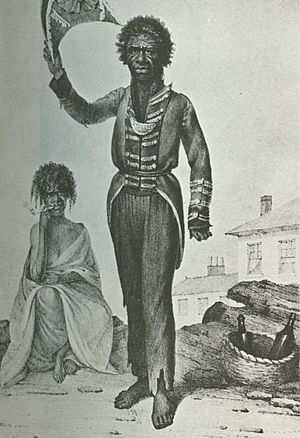Bungaree facts for kids
Bungaree (born around 1775, died November 24, 1830) was an important Aboriginal Australian leader. He came from the Broken Bay area, which is north of Sydney. Bungaree was known as an explorer, an entertainer, and a community leader. He was also the first person recorded in print as an "Australian." Plus, he was the first Australian to travel all the way around the continent by ship!
Contents
Bungaree's Life and Adventures
When Bungaree moved to the growing settlement of Sydney in the 1790s, he became a well-known person. He was able to move easily between his own people and the new European settlers.
Joining Matthew Flinders
In 1798, Bungaree joined the crew of HMS Reliance on a trip to Norfolk Island. During this journey, he impressed the explorer Matthew Flinders. Later that year, he went with Flinders on a small ship called the Norfolk. They were surveying the coast. Bungaree acted as an interpreter, guide, and negotiator with local Aboriginal groups.
Even without a common language, Aboriginal people often preferred to speak with Bungaree instead of Flinders. His skills in helping people understand each other were very helpful to the Europeans on the ship. For example, in 1799, Bungaree gave a spear and a spear thrower as gifts to local people. He showed them how to use these items. This helped create a friendly agreement. Some historians believe that the local people might have thought Bungaree was the leader of the expedition!
Bungaree was chosen by Flinders for a huge journey around Australia between 1801 and 1803. They sailed on Investigator. Flinders was creating the first complete map of Australia. He also strongly suggested naming the continent "Australia."
Flinders called Bungaree "a worthy and brave fellow." He said Bungaree saved the expedition many times. Bungaree was the only Aboriginal Australian on the ship. This meant he played a very important role in talking to different Aboriginal groups along the coast. He helped overcome big language differences.
Historians say Bungaree chose to be a "go-between." He often calmed down Aboriginal people who were about to attack the sailors. He would take off his clothes and speak to them, even in areas he didn't know. Flinders later wrote about Bungaree's "good disposition and open and manly conduct." He also mentioned Bungaree's kindness to the ship's cat, Trim.
A Respected Leader
In 1815, Governor Lachlan Macquarie gave Bungaree the title "Chief of the Broken Bay Tribe." He also gave him 15 acres (about 60,000 square meters) of land at George's Head. Bungaree also received a special breastplate that said "BOONGAREE – Chief of the Broken Bay Tribe – 1815."
Bungaree was also known as "King of Port Jackson" and "King of the Blacks." His main wife, Cora Gooseberry, was known as his queen.
Bungaree continued to join exploration trips. In 1817, he went with Captain Phillip Parker King to north-western Australia on the Mermaid. He even gave advice on which plants were safe to eat!
In 1820, Captain Faddei Bellingshausen mentioned Bungaree's friendly visit to his Russian exploration ship, the Vostok.
Later Life and Legacy
Bungaree spent the rest of his life officially welcoming visitors to Australia. He also taught people about Aboriginal culture, especially boomerang throwing. He would often ask for gifts, especially from ships visiting Sydney. He was also important within his own community. He took part in corroborees (traditional Aboriginal ceremonies), traded fish, and helped keep the peace.
In 1828, Bungaree and his family moved to the Governor's Domain. They were given food rations. Bungaree was described as being very old and weak. He died at Garden Island on November 24, 1830. He was buried in Rose Bay. Newspapers like the Sydney Gazette and The Australian wrote about his death.
By the end of his life, Bungaree was a familiar sight in colonial Sydney. He often wore military and naval uniforms that had been given to him. His unique outfits and fame, along with his humor and ability to imitate people (especially governors), made him a popular subject for artists. Many portraits were painted of him.
Bungaree's Lasting Impact
- Boongaree Island, off the Kimberley coast in Western Australia, was named after him by Captain King in 1820.
- The suburb of Bongaree in Queensland is named after him.
- HMAS Bungaree was a ship used by the Royal Australian Navy. It was originally a cargo ship built in 1937, but it was turned into a minelayer (a ship that lays underwater mines) in 1941. It was named after him.
- In 2017, a Sydney Ferries ferry was named Bungaree.
A primary school in Rockingham, Western Australia, was named Bungaree in the late 1960s. However, the history of Bungaree, the man, has not always been taught at this school.
Even though Bungaree played a very important role in the exploration of Australia, his achievements have often been forgotten. There are statues of Flinders and even the cat Trim, but as of January 2019, there was no statue specifically recognizing Bungaree's achievements.
Images for kids



